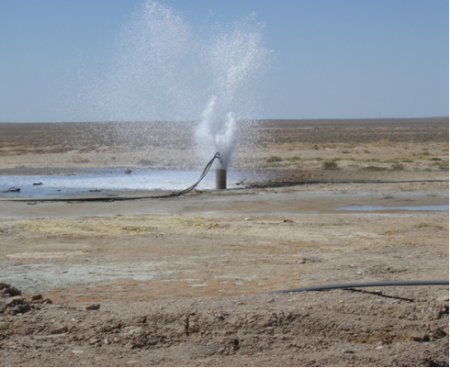
Microorganisms in the processes of underground leaching
Abstract
Microbial diversity in pumping-out solutions of uranium by underground leaching was studied. It was established that pumping-out solutions in pH 3.0 and higher intensifies and stimulates development of mixotrophic thionic bacteria. Supplying oxygen by pumping air into wells leads to intensification of uranium carryout, which is accompanied by considerable increase in growth of almost all studied groups of microorganisms, especially those related to thionic neutrophils and Pseudomonas genus bacteria. The increased activity of these groups of microorganism may lead to higher concentration of uranium in solution.
Full Text:
PDFReferences
Johnson D.B. Development and application of biotechnologies in the metal mining industry. Environ Sci Pollut Res Int. 2013 Nov;20(11):7768-76.
Ajim S. Sutar, Sanket D. Awasare Bioleaching of ore using chemolithotrophic microorganisms (Acidithiobacillus ferrooxidans). International Journal of Research in Environmental Science and Technology. 2015; 5(1): 14-21. Available online at http://www.urpjournals.com
Schippers A., Hedrich S., Vasters J., Drobe M., Sand W., Willscher S. Biomining: metal recovery from ores with microorganisms. Adv. Biochem. Eng. Biotechnol. 2014;141:1-47.
Tolstov E.A., Latyshev V.E., Lilbok L.A., Kukanova S.I., Zaynitdinova L.I. Application of biogeotechnology at leaching of poor and persistent ores. Gorniy zhurnal. 2003; 8:63-64.
Brierly J.A. Expanding role of microbiology in metallurgical processes. J. Mining Engineering. 2000; 11 (52):49-53.
Wolfson F.I., Korolev K.G. Conditions of formation of uranium deposits. Moscow, Nedra publishing house, 1990. 286 pp.
Karavayko G.I., Rossi J., Agate A., Grudev S., Avakyan Z.A. Biogeotechnology of metals. Guide book. Moscow, Center of International Projects GKNT, 1989. 375 p.
Abdollahy Mahmoud, Shojaosadati Sayed Abbas, Zare Tavakoli Hasan, Valivand Ali. Bioleaching of Low Grade Uranium Ore of Saghand Mine. Iran. J. Chem. Eng. 2011; 30 (4): 71-77.
Phillips E.P., Landa E.R., Lovely D.R. Remediation of uranium contaminated soils with bicarbonate extraction and microbial U(VI) reduction. J. Ind. Microbiol.1995; 14: 203-207.
Francis A.J. Microbes affect the speciation of various uranium compounds in wastes and soil. In uranium – Past and Future Challenges, B.J. Merkel and A.Arab, Eds., 2015: 333-346.
Berthelin J., Muner-Lamy C., Magne R. The involvement of chemoorganotroph microorganisms and uptake of uranium and associated metals from different rock materials. 8th Int. Biotechnol. Symp. Paris, 1989: 2:1082-1093.
Kalinowski B.E., Oskarson A., Arlinger J., Albinsson Y., Pedersen K., Odegaard-Jensen A., Andlid T. Bioleaching of heavy metals from pristine and naturally leached uranium ore from the closed mine at Ranstad, Southern Sweden. Geomicrobiology. Denver Annual Meeting, Colorado Convention Center, 27–30 October, 2002: 108-112.
Kukanova S.I. Heterotrophic microorganisms and their role in the processes of gold extraction from non-standard raw material. PhD thesis. Tashkent: 1992. Available from: http://earthpapers.net/geterotrofnye-mikroorganizmy-i-ih-rol-v-protsessah-izvlecheniya-zolota-iz-nestandartnogo-syrya
Robert T. Anderson, Derek R. Lovley. Microbial redox interactions with uranium: an environmental perspective. In: Miranda J., Keith-Roach, Francis R. Livens.Interacfions of microorganisms with radionuclides. USA; 2002: 205-223.
Kanaeva Z.K., Kanaev A.T. Microbiocenoses of chemolytotrophic bacteria of solutions of underground leaching of uranium deposits “Uvanas†and “Mynkudukâ€. Fundamental studies, 2012; 11-1: 20-24.
Bergey's manual of systematic bacteriology, 2nd ed. /Ed. G. Garrity. N.Y.: Springer Verlag, 2001. 721 p.
Refbacks
- There are currently no refbacks.
